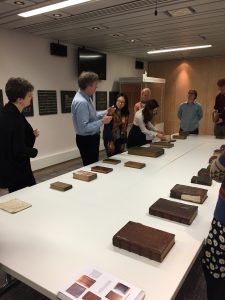A snap from the second of David Pearson’s masterclasses on early modern bookbindings, held last week in the Cambridge University Library. The classes were a reminder that a rare books library is an extraordinary collection of dead animal skins, a mausoleum for the thousands of pigs, sheep, cows and goats that gave their lives in part to make words on paper more durable. The sessions were also an encounter with the mystery of design, as they traced the changing decorative fashions that allow a trained eye to date a binding quite precisely to a particular period.
Somewhere inside me I still have a logocentric self that thinks bindings don’t matter–they are just there to serve the words. Perhaps that is reinforced by the fact that the vast majority of bindings are distinctly plain and functional, turning the book into something sturdy and everyday. But to face up to the scale of the premodern binding trade, and of the extraordinary price-differentiation of the products that it produced, is to realise that books were once choice objects, things to flash around as evidence of wealth, taste and social status. Our thanks to David for making this sometimes arcane world accessible once more.
